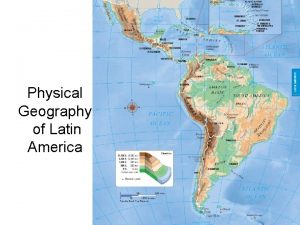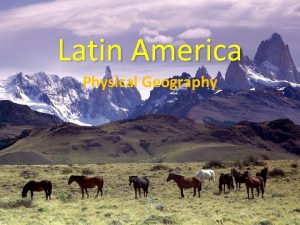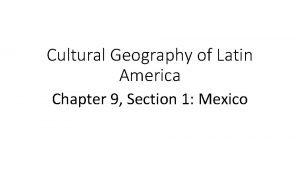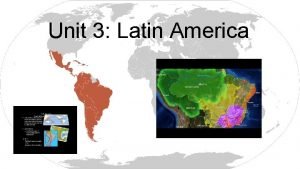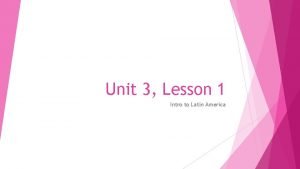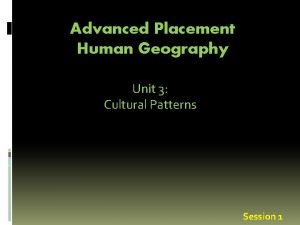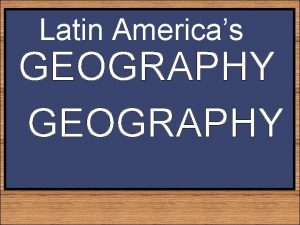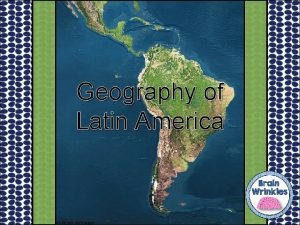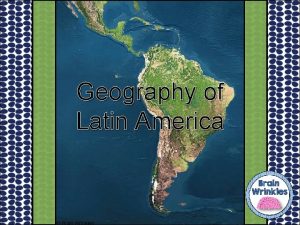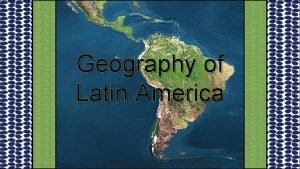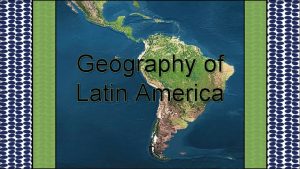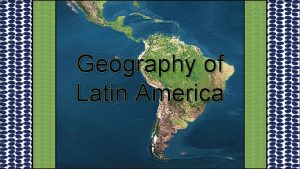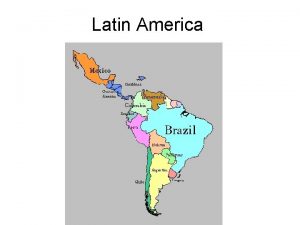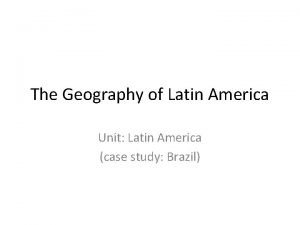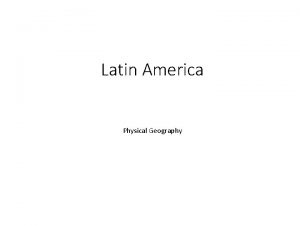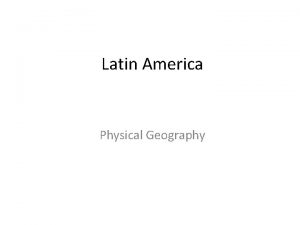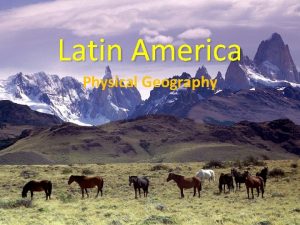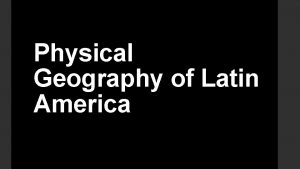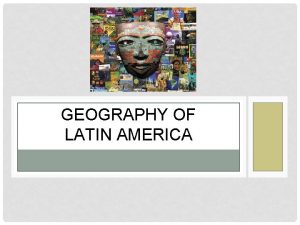Latin American Review Latin American Geography Latin America




















- Slides: 20

Latin American Review

Latin American Geography Latin America is made up of countries from North America, Central America, South America and the Caribbean Islands. n The cultures of this region reflect a combination of native beliefs and colonial powers. n

Topography n Major topographical features: – Sierra Madre Mountains – Yucatan Peninsula – Amazon Basin – Andes Mountains – Brazilian Highlands – Patagonia For a Geography essay what could you write about?

Pre-Columbian Civilizations Olmec empire 1400 BC to 500 BC n located along the Gulf coast of Mexico n Built ceremonial centers, invented a calendar, a system of writing and trade links n Maya 300 to 900 Large city-states in southern Mexico and Central America n maize and cocoa n Priests held high position in society, social hierarchy n giant temples, palaces, wall paintings, agricultural, picture system of writing, 365 day calendar, concept of zero, astronomy n n

Aztecs n n n n Valley of Mexico and established Tenochtitlan 1315 central Mexico Wealthy from tribute 30 million people Emperor, nobles, priests and warriors pyramids and human sacrifices to gods calendar, emperor’s palace, floating gardens, and pyramids

Inca n n n Andes Mts. And extended 2, 500 miles down the pacific coast Emperor at CUZCO. roads and armies could move quickly 12, 000 miles or roads, Cuzco, Temple of the Sun, terrace farming, surgery and medicinal herbs. Quipus: records kept by colored strings and knots.

Exploration and European Conquest n n n n Europeans looking for routes to riches of Asia Technology of printing press, gunpowder and cartographers and the astrolabe allowed for the success of exploration Columbus reaches the Americas and in 1494 Spain and Portugal split the Americas in the Treaty of Tordesillas. Conquistadors =Gold God and Glory 1519 -1521 Hernan Cortes conquers the Aztec empire 1532 Francisco Pizarro destroyed the Incan Empire in Peru Spread of Roman Catholicism

Reasons for Spanish Success n armor, horses and weapons n Spanish formed alliances with other Native American groups n Disease killed millions of Native Americans

Columbian Exchange Maize potato sweet potato Peanut squash beans Tomato Tobacco avocado Wheat Sugar Rice Banana Pig Horse Wine Chicken Small pox Measles typhus Exchanges from the Americas to Europe

Social Structure of the Spanish Colonies Peninsulares People born in Spain Creoles Mestizos: People of mixed European and native descent Mulattoes: people of mixed African and European descent Native peoples and peoples of African descent

Independence Movements in Latin America

Long Term Causes European domination n Enlightenment ideas of Locke, Rousseau & Montesquieu n American and French Revolutions n Growth of nationalism n

Toussaint L’Ouverture Born into slavery n Son of a Noble West African Family n Learned to read n Inspired by stories of revolt in ancient Rome and Julius Caesar n

1804 Haiti Independente Toussaint was betrayed and seized by Napoleon’s men n Ten months later in a French prison Toussaint died n the only non slave nation in Western Hemisphere n

Mexican Independence n n n Father Miguel Hidalgo – el Grito Dolores supported by poor Mexicans Mestizos and Native Americans march to Mexico city Called for an end to slavery Before 1811 he was executed n n n Father Morelos, a mestizo, called for the end of slavery and suffrage for all men He was captured and shot Conservative Creole Agustin de Iturbide feared colonial reform 1821, backed by Creoles, mestizos and Native Americans he overthrew Spanish Viceroy Life for most changed little

Simon Bolivar Acts Simon Bolivar, an educated Creole, saw Napoleon’s occupation of Spain the signal to act n In 1810 he led an uprising that established a republic in Venezuela n Civil war raged & Bolivar forced into exile n

“The Liberator” n n 1819 Bolivar marches army across the Andes and attacks at Bogotá 1821 he freed Caracas, Venezuela Moves into Peru, Ecuador and Bolivia Joins forces with Jose de San Martin

Jose de San Martin n n San Martin , a Creole like Bolivar, was born in Argentina 1816 he won freedom for Argentina He led an army across Andes into Chile 1822 San Martin stepped aside & Bolivar won final victories against Spain

Independence for Brazil Portuguese King fled Napoleon to Brazil n Instituted reforms n Leaves son Dom Pedro to rule Brazil n “If Brazil demands independence, proclaim it yourself and put the crown on your own head. ” n In 1822 Dom Pedro became Emperor

Long-Term Effects l 18 separate republics are established l Struggle to achieve stable democratic governments & to gain economic independence l Ongoing efforts to bring prosperity & democracy to the people of Latin America
 Why is latin america called latin america
Why is latin america called latin america Physical features of south america
Physical features of south america Voluntary trade comprehension check
Voluntary trade comprehension check Rio grande river
Rio grande river Chapter 9 cultural geography of latin america answers
Chapter 9 cultural geography of latin america answers Traje tipico de soloma
Traje tipico de soloma Chapter 8: the physical geography of latin america answers
Chapter 8: the physical geography of latin america answers Unit 3 latin america
Unit 3 latin america We can do a rap of the map of the us
We can do a rap of the map of the us North america south america europe asia
North america south america europe asia Repetition in let america be america again
Repetition in let america be america again Happening body art
Happening body art South america facts geography
South america facts geography Web quest: geography of the spanish speaking world
Web quest: geography of the spanish speaking world Lesson 1 latin america africa and the middle east
Lesson 1 latin america africa and the middle east Ap human geography frq examples
Ap human geography frq examples 5 themes of geography ap human geography
5 themes of geography ap human geography Stateless nation
Stateless nation First people in the world
First people in the world World history and geography final exam study guide
World history and geography final exam study guide Ap human geography unit 3 review
Ap human geography unit 3 review

